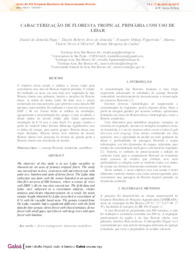Caracterização de floresta tropical primária com uso de Lidar.
Caracterização de floresta tropical primária com uso de Lidar.
Author(s): PAPA, D. de A.; ALMEIDA, D. R. A. de; FIGUEIREDO, E. O.; OLIVEIRA, M. V. N. d'; CUNHA, R. M. da
Summary: O objetivo desse estudo é utilizar o sensor Lidar para caracterizar uma área de floresta tropical primária. O estudo foi realizado no Acre, em uma área com vegetação do tipo floresta aberta com palmeira, bambu e manchas de floresta densa. A coleta de dados Lidar foi feita com o sensor embarcado em uma aeronave, que sobrevoou uma área de 800 hectares, onde também foi realizado o censo das árvores com DAP >=100; 40 cm. Foram feitas as análises de correlação, agrupamento e caracterização dos grupos. Como resultado, a altura média do dossel obtida pelo Lidar apresentou correlação de 0,74 com a área basal. Os grupos criados a partir da variável Lidar tiveram diferença significativa com os dados de campo, para quatro grupos: floresta densa com copas fechadas, floresta densa com abertura de dossel, floresta aberta com presença de árvores de grande porte e floresta aberta com ocorrência de bambu. The objective of this study is to use Lidar variables to characterize an area of primary tropical forest. The study was carried out in Acre, in an area with open forest type with palm tree, bamboo and spots of dense forest. The Lidar data collection was done with the sensor boarded in an aircraft, that flew an area of 800 hectares, where a census of trees with DBH >=100; 40 cm was also carried out. The field data and Lidar were subjected to a correlation analysis, cluster analysis and cluster characterization. As a result, the mean canopy height obtained by Lidar presented a correlation of 0.74 with the variable basal area. The groups created from the Lidar variable had a significant difference with the field data for four groups: dense forest with closed canopies, dense forest with small gaps, open forest with large trees and open forest with bamboo.
Publication year: 2019
Types of publication: Paper in annals and proceedings
Unit: Embrapa Acre
Keywords: Acre, Administração Florestal, Altura, Altura da copa, Altura del follaje, Amazonia Occidental, Amazônia Ocidental, Analysis of variance, Análise Estatística, Análise de variância, Análisis de varianza, Análisis estadístico, Bosques tropicales, Campo Experimental, Canopy height, Drone, Embrapa Acre, Espécie Nativa, Floresta Nativa, Floresta Tropical, Forest management, Identificação, Indigenous species, Lidar, Manejo florestal, Método Estatístico, Remote sensing, Rio Branco (AC), Sensoriamento Remoto, Statistical analysis, Teledetección, Tropical forests, Unmanned aerial vehicles, Vehículos aéreos no tripulados, Western Amazon
Observation
Some of Embrapa's publications are published as ePub files. To read them, use or download one of the following free software options to your computer or mobile device. Android: Google Play Books; IOS: iBooks; Windows and Linux: Calibre.
Access other publications
Access the Agricultural Research Database (BDPA) to consult Embrapa's full library collection and records.
Visit Embrapa Bookstore to purchase books and other publications sold by Embrapa.

